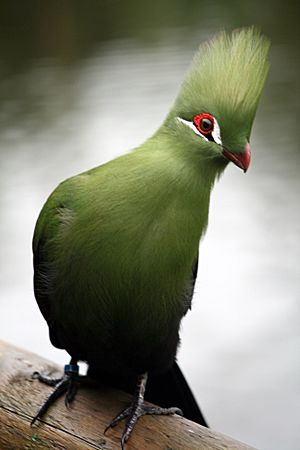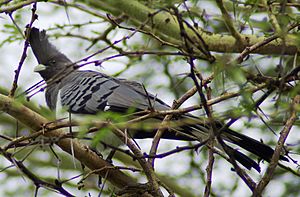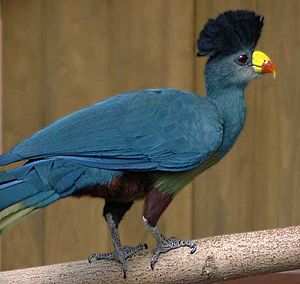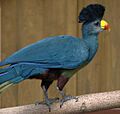Turaco facts for kids
Quick facts for kids Turacos and relatives |
|
|---|---|
 |
|
| Guinea turaco (Tauraco persa) at Birds of Eden aviary, South Africa | |
| Scientific classification |
|
| Kingdom: | Animalia |
| Phylum: | Chordata |
| Class: | Aves |
| Clade: | Otidimorphae |
| Order: | Musophagiformes Seebohm, 1890 |
| Family: | Musophagidae Lesson, 1828 |
| Genera | |
|
|
| Synonyms | |
|
|
Turacos are a family of colorful birds called Musophagidae. This name means "banana-eaters," but they actually eat many different fruits! This bird family also includes plantain-eaters and go-away-birds. In southern Africa, people often call them loeries.
These birds have a special foot design. Their fourth (outer) toe can swing forward and backward. Their second and third toes always point forward. Many turacos have cool crests on their heads and long tails. Turacos are famous for their unique bright green and red feathers, which get their color from special pigments.
Scientists used to think turacos were related to cuckoos. But now, thanks to new studies, they are in their own special group called Musophagiformes.
Turacos are one of the few bird families found only in Africa. They mainly eat fruit, but they also enjoy leaves, buds, and flowers. Figs are a big part of their diet. They have rounded wings and strong legs. This means they are not great at flying long distances, but they are very good at running and climbing.
Turacos are medium-sized birds that live in sub-Saharan Africa. You can find them in forests, woodlands, and savannas.
They like to live in groups, usually family groups of up to 10 birds. They don't migrate, meaning they stay in the same area. Many species are quite noisy. Go-away-birds are especially known for their loud calls, which warn other animals about predators. Their name "go-away-bird" comes from the sound of their call! Musophagids build large stick nests in trees and lay 2 or 3 eggs. Their chicks are born with thick downy feathers and can see right away, or almost right away.
Contents
What Turacos Look Like

Most turacos are medium-sized birds, except for the really big great blue turaco. They have long tails and short, rounded wings. They can be anywhere from 40 to 75 centimeters (16 to 30 inches) long. They are not strong fliers, but they are amazing climbers. They can move easily on branches and through thick plants. Young turacos even have small claws on their wings to help them climb!
Their feet are very flexible. The fourth toe can swing all the way to the back, almost touching the first toe. Even with this flexibility, the toe usually stays at a right angle to the foot.
Go-away-birds and plantain-eaters are mostly grey and white. But turacos are very colorful, often blue, green, or purple. The green color in turacos comes from a special pigment called turacoverdin. This is the only true green pigment found in birds! Other "green" birds get their color from yellow pigments mixed with how their feathers scatter light, which makes them look blue.
Turaco wings also have a red pigment called turacin. Most other red birds get their color from different pigments called carotenoids. Both turacoverdin and turacin are unique to the turaco family. Scientists are very interested in why turacoverdin is found in forest-dwelling turacos but not in those living in savannas.
We don't know much about how long wild turacos live. But in zoos, they live a very long time, easily reaching 30 years old. One bird in England lived for almost 37 years!
How Turacos Evolved
Scientists have found fossils that help us understand how turacos evolved. Some very old fossils of birds that might be turacos have been found in Europe and Africa. It seems like the turaco family might have first appeared in central Europe or northern Africa a long, long time ago, during the Oligocene period (about 24 to 34 million years ago). Later, they moved south to where they live today in Africa. The climate in Europe back then was similar to tropical Africa now, so it was a slow, natural move.
One very old fossil bird, Foro panarium, found in the United States, is now thought to be an early relative of turacos.
Scientists continue to study turaco family trees using DNA and other methods. The IOC World Bird List currently recognizes 23 species of turacos. However, new research suggests there might be as many as 33 different species!
Different Types of Turacos
Here are some of the main groups and examples of turaco species:
- Great Blue Turaco (Corythaeola cristata)
- Go-away-birds and Plantain-eaters (Genus Crinifer)
- Western plantain-eater (Crinifer piscator)
- White-bellied go-away-bird (Crinifer leucogaster)
- Grey go-away-bird (Crinifer concolor)
- Crested Turacos (Genus Gallirex)
- Purple-crested turaco (Gallirex porphyreolophus)
- Rwenzori turaco (Gallirex johnstoni)
- Other Turacos (Genus Tauraco and others)
- White-cheeked turaco (Menelikornis leucotis)
- Red-crested turaco (Tauraco erythrolophus)
- Guinea turaco (Tauraco persa)
- Knysna turaco (Tauraco corythaix)
- Black-billed turaco (Tauraco schuettii)
- Violet turaco (Tauraco violaceus)
- Ross's turaco (Tauraco rossae)
Turacos and People
The bright red feathers of turacos have always been special. In Africa, kings and chiefs used them as symbols of their power and importance. The Swazi and Zulu royal families, for example, valued these feathers greatly.
An old British bird expert named Constantine Walter Benson, who studied many birds in Africa, supposedly tried eating every bird he collected. He claimed that turacos tasted the best!
Images for kids
See also
 In Spanish: Turacos para niños
In Spanish: Turacos para niños



